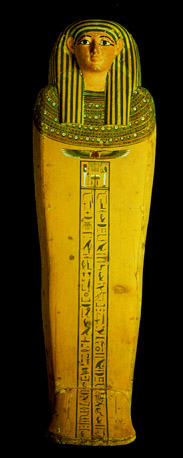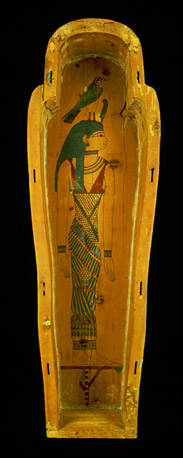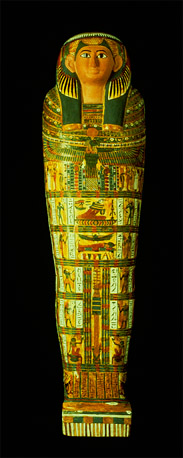LOVE LIES
Love lies sleeping
In a coffin.
How else can she dream?
Perhaps she is yellow
Unlike bird
Or fruit
But as the sun itself
Slumbering beneath
Blind eyes.
Can we believe
This a gift
Worth giving,
Receiving?



Nes-mut-aat-neru's middle and inner coffins
The ancient Egyptians believed that in the afterlife, the spirit (ka) of the deceased returned to the body, so it was important for it to be preserved to ensure that the ka had a safe home for eternity. Internal organs were removed, preserved, and stored in canopic jars outside the mummy case, and the body was dehydrated with natron salts and wrapped in yards of linen. This process, which took about three months, was accompanied by many elaborate rituals invoking the aid of gods to ensure a safe passage to the afterlife. Nes-Mut-aat-neru, buried ca. 700-675 BCE, was the wife of a high-ranking Theban priest. Her sarcophagus was excavated from the temple of Hatshepsut in Thebes by Edouard Naville for the Egypt Exploration Fund in 1895, along with two wooden boxes filled with mud shwabati figures molded in the shape of a mummified person, intended to do any work that the gods asked the deceased's spirit to do in the afterworld. Her mummy was wrapped in pink linen, with a bead network of blue faience beads, a winged scarab, and four sons of Osiris, and placed in a brightly painted wooden coffin, of a type that replaced cartonnage cases. It takes the form of a mummified body standing on a pedestal, and is supported in back by a djed-pillar, the hieroglyph for stability and emblem of Osiris; it provides symbolic support for the mummy and displays an inscription detailing Nes-mut-aat-neru's family (daughter of Tjaenwaset and Neskhonspakhered, mother of Djeddjehutyiuefankh). The lid decoration is brightly painted on a layer of plastered linen. The picture of Nes-Mut-aat-neru wears a vulture headdress over a long wig, an elaborate broad collar, and a ram-headed pectoral. The body is divided by bands of hieroglyphic text into compartments containing images of deities associated with the afterlife. In the central scene, the deceased lies on a bier surrounded by Isis and Nephthys and surmounted by a winged scarab representing Khepri. Its elaborate decoration reveals her status as a member of the aristocracy. This coffin was then put in a large anthropoid coffin of wood, simply decorated but beautifully worked. Most of the lid is plain, but the face, wig and broad collar are plastered and brightly painted. On the chest is a winged sun disk, a vignette showing the deceased before Ra-Horakhty, and two partially undecipherable columns of inscription. The first column reads, "Recitation, Osiris, the Lady of the house Ns-mwt-Aa-nrwt, the daughter of the beloved of god… Southern Hieliopolis, TA-n-WAst. Her mother is the Lady of the house Ns-nsw-pA-Xrd, the vendicated, the revered;" the second column, "Recitation, Hail to you, xnty-imnty, Osiris who is in the midst of Abydos. May you give abundance of offerings to the Beautiful West so that I might recieve from the Lords of the Necropolis, who said to me …" The inside of the base is painted with a full-length figure of a goddess. Then the entire ensemble was placed in an outer column, an undecorated rectangular sycamore box with a vaulted sycamore lid and four corner posts. The posts and framing are made of a reddish wood, with white bands inscribed with standard offering formulae, addressed to Osiris, Ptah-Sokar, Re-Horakhty, and Atum. A black-painted figure of Anubis, the jackal-headed god who was the patron of embalmers and protector of cemeteries, is affixed to the lid at the foot end of the coffin.
ReplyDelete